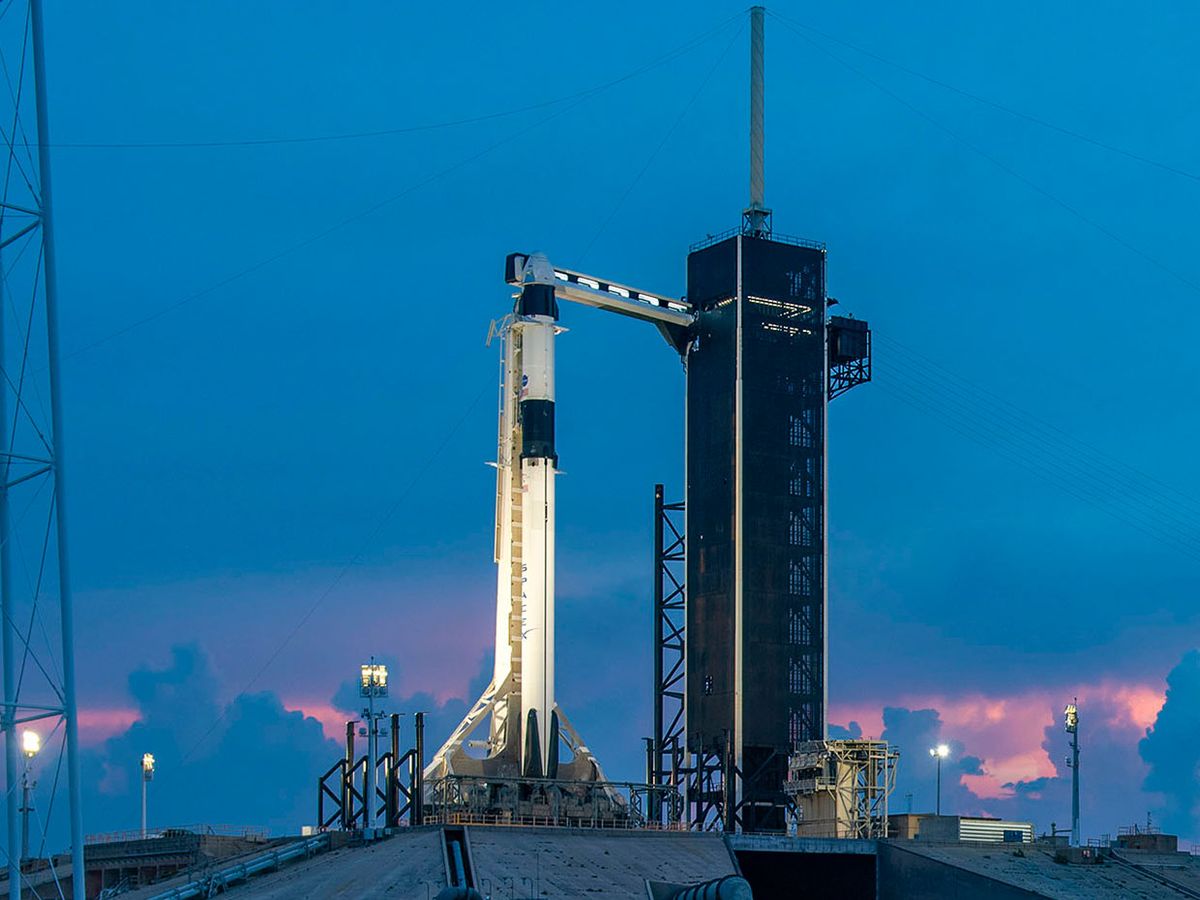With a “let’s light this candle,” and an ear-shattering roar and a blaze of light in Florida this afternoon, the United States rejoined an exclusive club of nations: those capable of launching people into space. Since the space shuttle fleet was decommissioned in 2011, American astronauts have had to hitch a ride on Russian Soyuz spacecraft. The launch today was the second attempt after the first attempt earlier this week was cancelled due to weather concerns. All went well, including a successful recovery of the the Falcon booster’s first stage, with a soft landing on the drone ship Of Course I Still Love You, stationed in the Atlantic.
This nine-year gap has highlighted how moribund the United States’ official space program has become: after all, between 1960 and 1969, NASA developed and flew three new crewed spacecraft—Gemini, the Apollo Command and Service Module, and the Lunar Lander, not to mention launch boosters such as the Saturn IB and Saturn V. But this return to human spaceflight marks more than just a return to the status quo, but a new epoch when commercial, rather than government entities, take the lead in designing, delivering, and operating new spacecraft. The Dragon 2 spacecraft and Falcon 9 booster were both created by SpaceX, the current leader in the still nascent world of private spaceflight.
To be clear, NASA has always relied on commercial contractors to build most of its hardware. Gemini was built by McDonnell Aircraft (now absorbed into Boeing) for example, and each of the Saturn V’s three stages was built by a separate company—Boeing, North American (now also part of Boeing), and Douglas (now part of Boeing too)—with the rocket’s instrumentation, telemetry, and computer module built by IBM. But during the Apollo era, NASA kept these contractors on a very tight leash, dictating many aspects of the design, and also had the advantage of vast budgets devoted to testing and debugging. NASA also exerted complete control of the entire flight from delivery of the hardware through launch and the subsequent mission.
But today, NASA’s took a back seat. While NASA’s mission control in Houston remains in charge of the overall mission to the International Space Station (ISS), SpaceX’s mission control in Hawthorne, California, was responsible for the launch and flight into orbit. The Dragon capsule won’t reach the ISS until tomorrow, when it will dock and essentially become part of the station until it is time for it to return.

The two astronauts flying onboard the Dragon—Robert Behnken and Douglas Hurley—are both veterans of the space shuttle program. SpaceX’s replacement is like the shuttle in that it is intended to be a largely resuable mode of transport, including a booster that can fly itself home to a safe landing, but the overall approach is more reminiscent of the Gemini spacecraft of the 1960s than anything since.
Few remember today, but the snub-nosed, matt-black-and-white Gemini spacecraft, with their stylish red trim, were originally designed with reusability in mind. Components were arranged to make servicing between flights easier, and a version was in the works to bring astronauts to and from a military space station, the Manned Orbiting Laboratory (MOL). The MOL was cancelled abruptly, and so only one refurbished Gemini capsule was ever reflown in an uncrewed test, and its planned role as a reusable space station visitor largely forgotten.
Like Gemini, the Dragon 2 is comprised of two main components: a bell-shaped crew compartment with a curved heatshield and an unpressurized “trunk” section behind the heatshield that acts as both an adapter for mating the spacecraft to the launch rocket and provides additional payload space. Like Gemini, when returning to Earth, the unpressurized section is jettisoned, and the crew capsule alone makes a so-called “blunt body” descent through the atmosphere before releasing parachutes and splashing down in the ocean for pickup.
But the Dragon 2 also features enormous improvements. For one thing, it’s much bigger than Gemini, capable of carrying up to seven people, compared to Gemini’s two. The unpressurized section is also coated with solar cells to generate power, a first for U.S. crewed spacecraft, which previously relied exclusively on batteries or fuel cells. The crew capsule is also outfitted with rockets that are powerful enough for orbital maneuvering, while Gemini relied on thrusters in its disposable section. These rockets also mean that the crew capsule is capable of being its own launch escape system, pulling the crew to safety in the event of a booster failure. Gemini relied on two airplane-style ejector seats for launch emergencies, something that few astronauts seemed to have any confidence in.
The Dragon spacecraft also has a sophisticated autonomous guidance system: in theory, astronauts could just sit back at launch and let the spacecraft fly all the way into dock at the ISS. However, during this proving flight, the astronauts will take control of the spacecraft to test the manual backup controls, albeit in a much slicker manner than the old Gemini days, when Buzz Aldrin had to bust out a sextant to make a rendezvous after Gemini 12’s radar stopped working. The new system interface is more reminiscent of a video game than a piece of navigation equipment—in fact, you can try your own hand at space station docking using a replica of the interface online.
Exactly how long the crew will stay onboard the ISS is unknown, although there is a limit of 119 days due to concerns about the longevity of the Dragon’s solar panels in orbit.
Stephen Cass is the special projects editor at IEEE Spectrum. He currently helms Spectrum's Hands On column, and is also responsible for interactive projects such as the Top Programming Languages app. He has a bachelor's degree in experimental physics from Trinity College Dublin.



